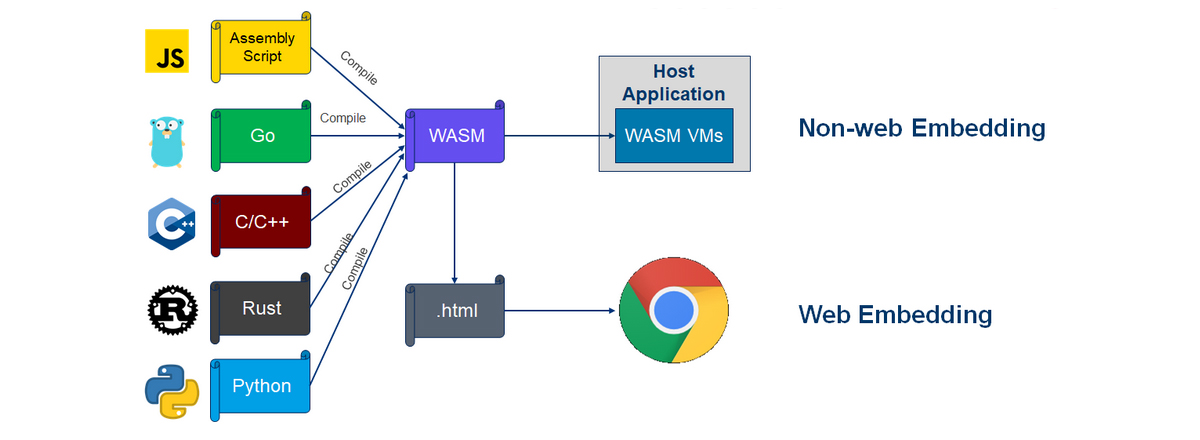Design WebAssembly (Wasm) Website Development
WebAssembly (Wasm) represents a revolutionary advancement in custom website development, providing a powerful binary instruction format designed to run at near-native performance within web browsers. This technology was developed collaboratively by major affordable website development services to help browser vendors, including Google, Microsoft, Mozilla, and Apple, to enable high-performance web applications and extend the capabilities of web browsers beyond what is achievable with traditional web technologies.
One of the key features of WebAssembly is its ability to execute code at near-native speed, making it well-suited for computationally intensive tasks and applications that demand optimal performance. Unlike JavaScript, which is traditionally the primary language for web development, WebAssembly allows cheap website development deals for developers to use languages like C, C++, or Rust. This is a game-changer, as these languages are known for their efficiency and are commonly used in systems programming and performance-critical applications.
WebAssembly operates alongside JavaScript and can be easily integrated into existing web applications for the best website development help. Developers can compile their code written in C, C++, or Rust into WebAssembly bytecode, which can then be executed in a web browser. This bytecode is highly efficient, as it is designed to be compact and load quickly, optimizing both download times and execution speed.

The adoption of WebAssembly has opened up new possibilities for web developers, enabling them to create complex applications with performance characteristics previously only achievable through native development. Buy a website development service for WebAssembly, which is particularly beneficial for applications that involve heavy computational workloads, such as gaming, simulations, virtual reality (VR), and other scenarios where responsiveness and speed are critical.
WebAssembly's versatility extends beyond just web browsers. It can be utilized in various contexts, such as server-side applications and emerging technologies like edge computing. This adaptability makes WebAssembly a powerful tool for building a wide range of applications that require high performance across different computing environments.
One of the strengths of WebAssembly is its ability to facilitate interoperability between different programming languages. Developers can create modules in their language of choice and integrate them seamlessly into a broader application. This interoperability enhances code reuse, enabling teams to leverage existing codebases and libraries written in languages compatible with WebAssembly.
To conclude, WebAssembly is a transformative technology in web development, allowing developers to write high-performance code using languages traditionally associated with systems programming. Its near-native execution speed makes it a compelling choice for a variety of applications, ranging from sophisticated web applications to computational-heavy tasks. As WebAssembly continues to evolve and gain wider adoption, its impact on the web development landscape is likely to grow, offering new opportunities for creating faster, more efficient, and feature-rich web experiences.
Related Blogs
- Creating Engaging Social Media Graphics for Digital Marketing Success
- How to Use Custom Hashtags in Social Media Digital Marketing Posts
- How to design Social Media Thumbnails
- Get Details of the best Digital Marketing Companies
- Website Design Optimization Process
- Ways to Use Template or Theme with No Coding Website Design Experience
- Design WebAssembly (Wasm) Website Development
- How to Optimize Website Loading Speed?
- Google Sites: Best Online Website Design Builders
- What Are the Best Hosting Platforms for The Website Design?
- Specific Elements Needed in How to Website Design for an E-Learning Platform
- Agile Marketing: The Key to Keeping Up with Marketing Trends
- How to Avoid Ad Fatigue in Modern Digital Marketing Campaigns in 2024?
- How to Do Mastery of AI Assisted Tools in Digital Marketing?
- Tips to Migrate Html Blog Site to WordPress
- How to Set up GA4 Analytics for our Website for Enhanced Digital Marketing?
- Learn Spline 3D Design Integrating Spline/Webflow On Website Design Landing Page
- Importance of Source Files as AI, EPS, PDF, JPG, PNG Logo File Design
- Process of Low-Coding Website Design
- Tips to Remove Noise from Social Media Marketing Videos
- Tips for Divi Theme Site Optimization for Website Development
- How to Develop Carousal Style Websites?
- Open Source Integrated Web Development Environment
- Tips for CSS for a New Website Project to Modify Style of Search Bar
- How to Develop Online Store on Shopify Development
- Tips for Website Design for PSEE Basler Model Creation/Verification
- Tips for Dynamic Customized Website Design Using JavaScript Arrays
- How to Do Klaviyo Setup Assistant for Digital Marketing?
- Guide to Use Website Development Methodology Using AngularJS
- Importance of Using Flat Website Design to Enhance Brand Message
- How to Include Social Media Connectors in Website Development?
- Tech Stack and Infrastructure Natively Enable Digital Marketing Content Discovery
- How to Generate and Use Meta Ads in Digital Marketing?


